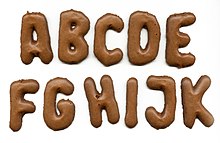Long-life baked goods
Dauerbackwaren are pastry , which for a long time durable are. They are different from bread and biscuits in that they contain less moisture and usually more sugar. This offers protection against microbial spoilage.
In a broader sense, canned bread and canned cakes also belong to the long- life baked goods. The canned bread finds z. B. Use as emergency bread in the event of a disaster and is sometimes also referred to as "ship's bread " or "soldier's bread ".
Long-life baked goods in the narrower sense include:
- Cookies and tea cakes such as shortcrust pastries, vanilla croissants ,
- Cookies such as hard biscuits , shortbread biscuits, speculoos
- Savory biscuits like crackers
- Pretzel pastries such as pretzel sticks
- Gingerbread cookies such as printen , honey cake , wafer gingerbread, gingerbread
- Russian bread
- meringue
- biscuit
- Baking wafers
- zwieback
- Macaroons
- Waffle biscuits
- Baked goods made from roasted pastries such as nut wedges , nutcrackers and Florentines
Manufacturing
For the production of long-life baked goods, low-gluten wheat flour and other liquid or solid ingredients are mainly used, which are further processed into dough (flour is the main component) or masses (other components predominate) in kneaders or mixers. The kneading or mixing process can be carried out either continuously or discontinuously. Constituents of the flour ensure that the dough or the mass stick together, and baking powder is usually used as a leavening agent and at the same time to loosen the baked goods .
The finished doughs or masses are brought into the desired raw shape by molding machines according to their consistency and then cooked in an oven. Cooking in the oven first causes the expansion of carbon dioxide from the leavening agent and, at higher temperatures, the evaporation of the water contained in the dough or in the mass; the gas retention capacity of the blank ensures that it has the desired porosity . At the same time the product is adhesive denaturation and starch stabilized gelatinisation and it is by chemical modification to form biscuits typical aroma substances . As a rule, the baking process for long-life baked goods takes place continuously and different temperature zones are passed through during the baking process in order to achieve the desired baking result. The ovens are mainly heated indirectly (no contact between fuel and baked goods) with gas; electrical energy is used for special applications (e.g. infrared heating ). The ovens are divided into certain sections according to the desired temperature in order to be able to set the desired temperature profiles. The baking belts for transporting the baked goods are made as mesh belts or sheet steel. The baking time is between two and nine minutes, depending on the product and baking temperature, which is usually between 150 and 350 ° C. Most of the baked goods produced in this way have a water content of around two percent.
After the baking process, the products are specifically cooled and packaged. A refinement such as B. the coating with chocolate , which makes a further cooling process necessary, can also be done. By choosing a water-vapor-tight packaging, the product is protected against moisture absorption or release.
literature
- W.-D. Arndt: Dauerbackwaren , in: Rudolf Heiss (Ed.): Food technology , 3rd edition, Springer-Verlag, Berlin, Heidelberg, 1990, ISBN 3-540-51737-5
- Keyword food , 3rd edition 2010, aid infodienst e. V., ISBN 978-3-8308-0935-7
Individual evidence
- ↑ German Food Book , Guidelines for Fine Baked Goods , Introduction, Explanation of Terms and Chapter III, Page 9
- ↑ a b Waldemar Ternes , Alfred Täufel, Lieselotte Tunger, Martin Zobel (eds.): Food lexicon . 4th, comprehensively revised edition. Behr, Hamburg 2005, ISBN 3-89947-165-2 . Page 387

